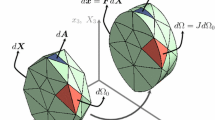Abstract
An algorithm is presented for the CAD-free conversion of linear unstructured meshes into curved high-order meshes, which are necessary for high-order flow simulations. The algorithm operates via three steps: (1) autonomous detection of feature curves along the mesh surface, (2) reconstruction of the surface curvature from the combination of surface node positions and feature curve positions, and (3) alignment of the mesh interior to the newly curved surface. The algorithm is implemented in our freely available cross-platform graphical software program meshCurve, which transforms existing linear meshes into high-order curved meshes



















Similar content being viewed by others
Notes
References
Bassi F, Rebay S (1997) High-order accurate discontinuous finite element solution of the 2D Euler equations. J Comput Phys 138(2):251–285
Carr JC, Beatson RK, Cherrie JB, Mitchell TJ, Fright WR, McCallum BC, Evans TR (2001) Reconstruction and representation of 3D objects with radial basis functions. In: Proceedings of the 28th annual conference on Computer graphics and interactive techniques. ACM, pp 67–76
Carr JC, Beatson RK, McCallum BC, Fright WR, McLennan TJ, Mitchell TJ (2003) Smooth surface reconstruction from noisy range data. In: Proceedings of the 1st international conference on Computer graphics and interactive techniques in Australasia and South East Asia. ACM, pp 119–ff
Geuzaine C, Remacle JF (2009) Gmsh: A 3-D finite element mesh generator with built-in pre- and post-processing facilities. Int J Numer Meth Eng 79(11):1309–1331
Geuzaine C, Remacle JF (2016) Changelog. http://gmsh.info/CHANGELOG.txt
Hamming R (2012) Numerical methods for scientists and engineers. Courier Corporation
Hartmann R, Harlan M (2016) Curved grid generation and DG computation for the DLR-F11 high lift configuration. In: ECCOMAS Congress 2016 on Computational Methods in Applied Sciences and Engineering, vol 2. National Technical University of Athens (NTUA) Greece, pp 2843–2858
Hindenlang F (2014) Mesh curving techniques for high order parallel simulations on unstructured meshes
Hindenlang F, Bolemann T, Munz CD (2015) Mesh curving techniques for high order discontinuous Galerkin simulations. In: IDIHOM: Industrialization of High-Order Methods-A Top-Down Approach. Springer, pp 133–152
Ims J, Duan Z, Wang ZJ (2015) meshCurve: an automated low-order to high-order mesh generator. In: 22nd AIAA Computational Fluid Dynamics conference
Jiao X, Bayyana NR (2008) Identification of C1 and C2 discontinuities for surface meshes in CAD. Comput Aided Des 40(2):160–175
Jiao X, Wang D (2012) Reconstructing high-order surfaces for meshing. Eng Comput 28(4):361–373
Karman SL, Erwin JT, Glasby RS, Stefanski D (2016) High-order mesh curving using WCN mesh optimization. In: 46th AIAA Fluid Dynamics Conference, p 3178
Kazhdan M, Bolitho M, Hoppe H (2006) Poisson surface reconstruction. In: Polthier K, Sheffer A (eds) Eurographics Symposium on Geometry Processing
Luke E, Collins E, Blades E (2012) A fast mesh deformation method using explicit interpolation. J Comput Phys 231(2):586–601
Luo X, Shephard MS, Remacle JF (2001) The influence of geometric approximation on the accuracy of high order methods. Rensselaer SCOREC report 1
Ray N, Delaney T, Einstein DR, Jiao X (2014) Surface remeshing with robust high-order reconstruction. Eng Comput 30(4):487–502
Runge C (1901) Über empirische Funktionen und die Interpolation zwischen äquidistanten Ordinaten. Zeitschrift für Mathematik und Physik 46(224–243):20
Shampine LF, Allen RC, Pruess S (1997) Fundamentals of numerical computing, vol 1. Wiley, New York
Tampieri F (1992) Newell’s method for computing the plane equation of a polygon. In: Graphics Gems III (IBM Version). Elsevier, pp 231–232
Trefethen LN, Bau III, D (1997) Numerical linear algebra, vol 50. Siam
Wang Z (2007) High-order methods for the Euler and Navier–Stokes equations on unstructured grids. Prog Aerosp Sci 43(1):1–41
Wang Z, Fidkowski K, Abgrall R, Bassi F, Caraeni D, Cary A, Deconinck H, Hartmann R, Hillewaert K, Huynh H et al (2013) High-order CFD methods: current status and perspective. Int J Numer Meth Fluids 72(8):811–845
Wang Z, Li Y, Jia F, Laskowski G, Kopriva J, Paliath U, Bhaskaran R (2017) Towards industrial large eddy simulation using the FR/CPR method. Comput Fluids 156:579–589
Xie ZQ, Sevilla R, Hassan O, Morgan K (2013) The generation of arbitrary order curved meshes for 3D finite element analysis. Comput Mech 51(3):361–374
Acknowledgements
This material is based upon work supported by NASA under Grant NNX12AK04A and also by the National Science Foundation Graduate Research Fellowship Program under Grant no. NSF0064451.
Author information
Authors and Affiliations
Corresponding author
Rights and permissions
About this article
Cite this article
Ims, J., Wang, Z.J. Automated low-order to high-order mesh conversion. Engineering with Computers 35, 323–335 (2019). https://doi.org/10.1007/s00366-018-0602-x
Received:
Accepted:
Published:
Issue Date:
DOI: https://doi.org/10.1007/s00366-018-0602-x




